The Apple Thunderbolt Display Review
by Anand Lal Shimpi on September 23, 2011 2:56 AM EST- Posted in
- Displays
- Mac
- Apple
- Thunderbolt
- Thunderbolt Display
Ever since I moved to a notebook as my main work computer I've become increasingly annoyed with the process of actually moving my notebook-as-a-desktop around. At my desk I've got DisplayPort, Ethernet, two USB, FireWire 800, speakers and power all plugged into a 15-inch MacBook Pro. What makes it frustrating isn't the first-world-problem of having to unplug seven cables, rather that it doesn't need to be seven cables - Apple could make the whole thing happen with just two.
Every Mac released in 2011 has at least one Thunderbolt port (the iMac has two), and Thunderbolt can deliver exactly what I'm looking for. Thunderbolt can carry two things: PCI Express and DisplayPort, the former for data and the latter obviously for video. Why would you want to carry PCIe and DP over a single cable? To address problems like the one above.
Pretty much all device expansion on modern day PCs happens via PCI Express. Several years ago it was hard to find PCIe sound cards or Ethernet controllers, but these days vanilla PCI slots are nearing extinction and PCIe is the de facto standard. Ethernet, USB and FireWire controllers all exist as single-lane PCIe devices. Put a bunch of them at the other end of a Thunderbolt cable and you no longer need to plug in a bunch of individual cables into your notebook when at your desk. Send DisplayPort over the same cable and you can actually move all of those ports onto your monitor, thereby using a single cable to carry everything but power to your display. And this is exactly what Apple has done with its new Thunderbolt Display. By mating its 27-inch LED Cinema Display with a bunch of integrated IO controllers, Apple is hoping to deliver a display that's more of a mobile docking station than just a passive way to display video.
Apple has tried this in the past. The old Cinema Displays used to feature an Apple Display Connector (ADC) that actually carried DVI, USB and power from a desktop Mac to the monitor. You only needed to plug in a single cable to your display, significantly reducing desktop clutter. Although Thunderbolt does carry power, it's limited to 10W - not enough to power any reasonably sized display. Where Thunderbolt does win out over ADC however is in its universal appeal. Intel created the standard. Although it's used almost exclusively on Apple systems today, come 2012 Intel is expecting PC OEMs to embrace the interface with its Cactus Ridge line of Thunderbolt controllers.

Apple's Thunderbolt Display
The Thunderbolt Display uses a near, if not perfectly, identical panel to what was in last year's 27-inch LED Cinema Display. You get a 27-inch, 16:9, 2560 x 1440 LED backlit display capable of at least 350 nits at full brightness. Apple seems to conservatively spec its desktop displays as we were able to measure 425 nits at max brightness. The uber brightness comes in handy because the display does have a glossy finish. Indoors it's not really a problem unless you're watching a dark movie scene with the display lit by a sun-facing window. Even then, cranking up the brightness all the way is usually enough to overcome any significant glare. As with all glossy displays, if you have light control (e.g. curtains or blinds) you'll be just fine.
The similarities don't end with the internal panel, the chassis is very similar to its older sibling and the Thunderbolt Display retails for the same $999 price.
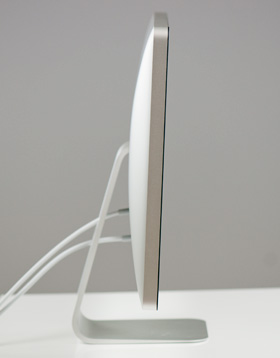 |
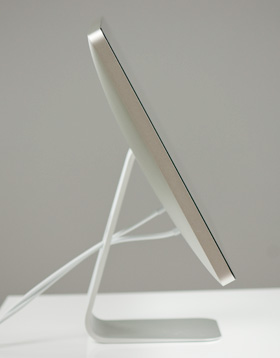 |
The display sits on an aluminum swivel base that allows for -5 degrees to 25 degrees of tilt along the horizontal axis. There's no height adjustment for the display either, only tilt. Personally, I use a height adjustable desk as I find it helps me avoid any carpal tunnel pain. Combined with a height adjustable chair, the lack of height adjustment on the display doesn't bother me. If you have a fixed height desk however, this may be a problem.
Aesthetically the Thunderbolt Display continues Apple's aluminum meets glass design language. The front of the display is all glass, while the edges and back are all aluminum. Along the top surface of the display is a mic for the integrated FaceTime HD camera. The outgoing 27-inch LED Cinema Display (still available for purchase online) sported a 640 x 480 camera, while the Thunderbolt Display ups capture resolution to 1280 x 720.
There's an ambient light sensor hidden in the top bezel of the display, but as always you can disable its functionality from within OS X.

There are two integrated speakers in the display, again unchanged from the previous LED Cinema Display.
Two cables attach directly to the display: a removable power cable and an integrated IO cable. Cable management is done through a round cutout in the aluminum stand. The IO cable is where things really change with the Thunderbolt Display. Instead of a breakout of three cables as was the case with the Cinema Display, there are now only two: MagSafe and Thunderbolt.
The MagSafe connector remains unchanged. If you've got any Mac that can be charged by an 85W MagSafe adapter, the Thunderbolt Display will charge said Mac. This feature alone is particularly awesome for notebook-as-a-desktop users since it allows you to just keep your actual AC adapter tucked away in your travel bag. For me I keep my MagSafe adapter in my bag and never take it out so I never have to worry about forgetting to pack it. Given how expensive MagSafe adapters are ($79 for an 85W), this is a nice feature for MacBook Air/Pro owners.
The Thunderbolt cable is obviously what gives this new display its name. Inside the Thunderbolt Display is an Intel Light Ridge Thunderbolt controller. The type of controller is important as it bestows upon the display some clear limitations. The biggest of course is the lack of support for all non-Thunderbolt systems. That's right, the only way to get video to the Thunderbolt Display is by using a Thunderbolt enabled Mac (or theoretically a Thunderbolt enabled PC). For Mac users that means only 2011 MacBook Pro, Air, iMac or Mac mini models will work with the Thunderbolt Display. Everyone else has to either buy a new Mac or stick with older displays.
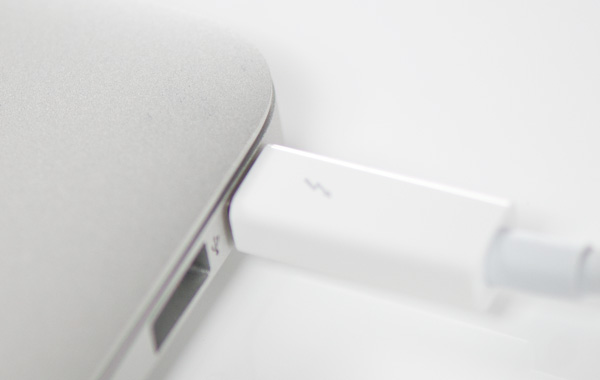
I believe the limitation here is actually on the cable side. A Thunderbolt cable can only transmit a Thunderbolt signal. Although DisplayPort is muxed in, if the display on the other end is expecting Thunderbolt and it receives DisplayPort it won't know what to do with it. It's possible Apple could have built in logic to autosense and switch between Thunderbolt and DisplayPort as inputs, but Apple traditionally employs clean breaks rather than long technology transitions. If Apple wants to ensure Thunderbolt gets adopted (at least by its users), this is the way to do it. As we learned from other legacy interfaces (e.g. PS/2, IDE), if you enable backwards compatibility you'll ensure the survival of systems that implement those interfaces. It's not so great for existing customers unfortunately.


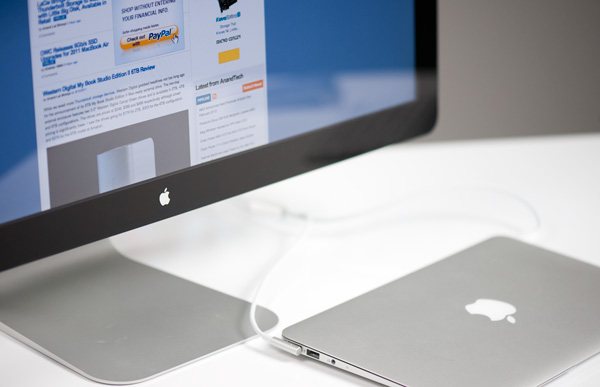
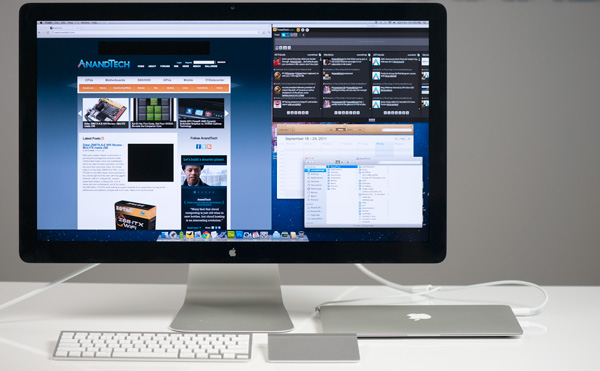
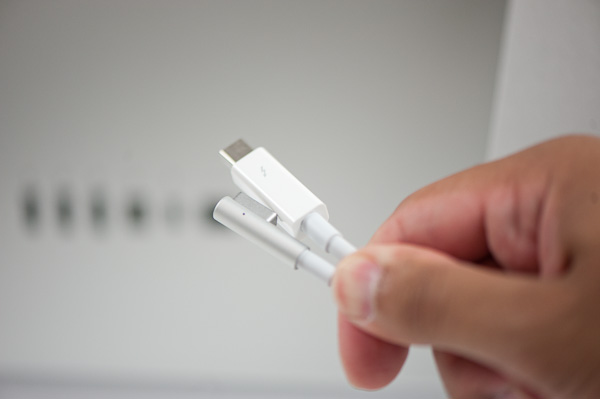








275 Comments
View All Comments
repoman27 - Tuesday, September 27, 2011 - link
This is the first display to include ports that have their own host controllers. All other displays either offer just multiple video input ports, or have an internal USB hub and various USB devices that are connected to the USB host controller on a PC via a separate cable. Some also have an audio input as well for a connection to a separate audio output on the PC. So yes, whole different ball game here.I'd rather have a $120k car that doesn't have a stereo or floor mats because they weigh too much. ;-)
I also like displays with height adjustment, but, and not to sound like a total Apple apologist here, Apple generally makes pretty good decisions about which features to include and which to leave out. Whenever you design an electronic gadget you have to make compromises. You can't cram every feature on the market into one device that's smaller and more beautiful than all the others and then sell it for an absurdly low price. The ATD is a pretty balanced package overall. Apple also doesn't have any currently shipping, proven, height-adjustable display stand designs at the moment. If they did, and simply omitted it for this product, it would be far more egregious.
Yeah, stupid consumer HDTV market completely killing the mid-range display market.
AnnonymousCoward - Tuesday, September 27, 2011 - link
The user doesn't care if there's a hub or host directly behind the USB port. It's a friggen USB port, just like my monitor has. And it'd be better if it were USB3, and if there were more than 3 ports. Plug in a mouse and keyboard, and you're quickly left with 1 remaining port, which isn't enough.You don't care to have a stereo in your car? Very odd. I'll take a 15k car with good sound over a silent 120k.
Dell has had their swivel adjustments figured out for several monitor generations. Apple has no excuse, and makes poor feature decisions over and over. Like back when their iPod Shuffle came out, for $90 or whatever and no screen, compared to another brand that cost $35, OLED screen, superior battery life, and functions like a flash drive without iTunes. In addition, Apple's price margins are so high that they can easily afford to add vital features, when competitors have them and sell for less.
repoman27 - Tuesday, September 27, 2011 - link
Of course you don't care how things work, you just buy based on bullet points put forth buy the marketers.How's the throughput on the Gigabit Ethernet port in your display? Does your display have any USB 3.0 ports? Does the PC that it's connected to even have any?
Yeah, and what you consider poor feature decisions have propelled Apple to the #1 ranking market cap in the world. Clearly shareholders are liking the feature set. How's the company that made that other brand doing these days? Dominating the market are they?
AnnonymousCoward - Tuesday, September 27, 2011 - link
Apple is "#1 market cap" because of their marketing department. NOT feature set, nor value.Constructor - Thursday, September 29, 2011 - link
You keep telling yourself that.In the real world, it is actually hard to make the right tradeoffs in product development. And cramming the absolute maximum number of paper features into a product quite often does a disservice to its actual usability and practical usefulness.
Apple's meteoric rise and sky-high user loyalty in large part comes from them in fact making the right decisions in most of these tradeoffs.
"Marketing" is a rather helpless catch-all pseudo-explanation for what many people (and even most competitors) simply fail to grasp. Which is why Apple is successful, and they are not.
AnnonymousCoward - Friday, September 30, 2011 - link
"paper features""disservice to its actual usability and practical usefulness."
-Oh, you mean like a mouse with a right-click button? Yeah, that's quite the paper feature with no practical usefulness!
-Or maybe like putting a screen on an MP3 player. That's yet another worthless paper feature!
-Or a monitor stand with height adjustment. That only looks good on paper! There's no practical usefulness here because every MacHead has a height-adjustable desk!
And don't get me started on the lack of value. You can get a new 15.6" laptop with a C2D-based Intel processor for $280; Apple laptops start at $1000. A while back you could get Apple's 30" (which used an outdated LG panel) for $2000, versus Dell's 30" (with a newer and better LG panel) for $1500, and it had swivel.
I credit the vast majority of Apple's success to their brilliant mass marketing.
crispbp04 - Sunday, September 25, 2011 - link
i just dock my computer and don't have to get flustered over seven cables. snap in and move on. snap off and leave.Constructor - Sunday, September 25, 2011 - link
And all the while there's the massive docking station cluttering up your desk. Which can't be used with any other computer and cannot be adapted to should you need anything it doesn't happen to provide.I'm not saying that it can't be useful, just that Thunderbolt is quite a bit more flexible, more powerful and more convenient.
dsumanik - Tuesday, September 27, 2011 - link
How is that different from a piece of wood or a stack of books for the display to sit on because there is no height adjustment?Constructor - Tuesday, September 27, 2011 - link
You'll need a display in addition to your docking station. The TBD already covers the docking needs, and you can still use the Air's keyboard and trackpad if you like, since there's only one thin cable going out from it, not much different from a USB keyboard cable.And as I explained before: Height adjustment built into the regular stands is usually too limited to be really useful where it's actually needed, and still fragile and wobbly at the same time (which is two things the iMac / Thunderbolt Display stand most certainly is not).
Theoretically demanding all kinds of things is one thing. Ticking them off on a theoretical spec sheet is another.
But the actual, practical reality is usually a completely different thing again. And that is what you have to deal with when you're actually constructing real-life hardware. It's not nearly as simple as is looks from the outside (I'm developing software, hardware and sometimes mechanical components for a living myself).
Bitching is easy. Finding really good solutions for difficult problems is not.